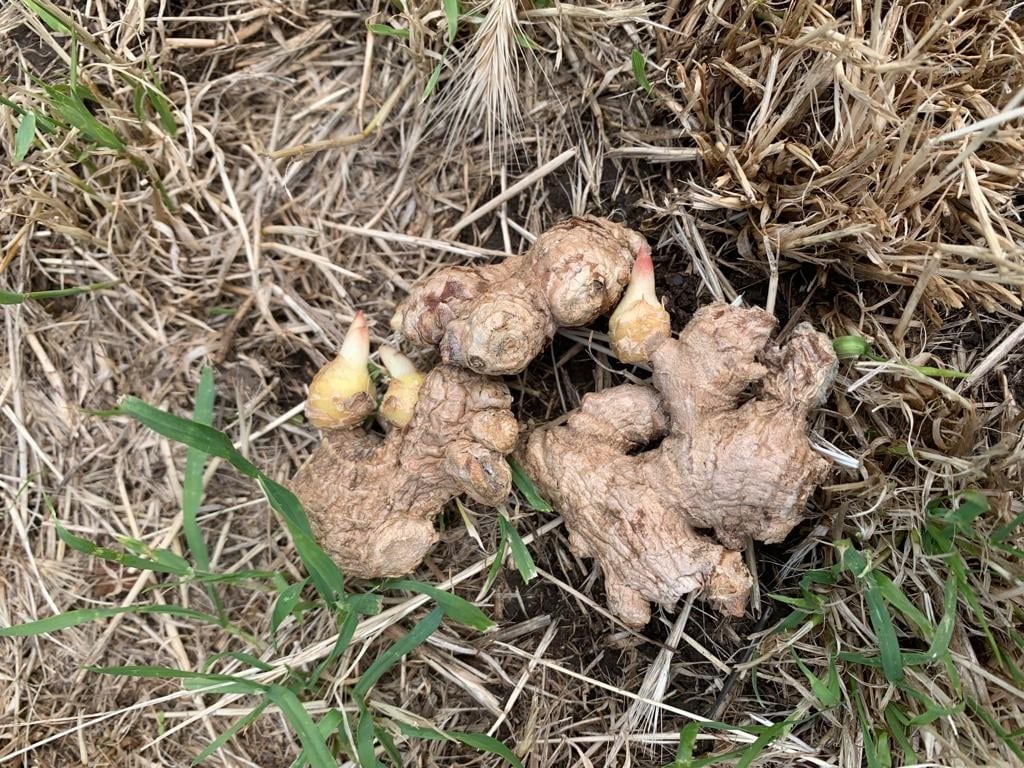
Looking to spice up your Gardening skills? Look no further than ginger planting in Ghana! With its vibrant flavor and numerous health benefits, ginger has become a cuisine staple. And what better way to enjoy its freshness than by growing it in your backyard?
In this guide, we’ll share expert tips and tricks to help you achieve a bountiful harvest of ginger right here in Ghana.
Whether you’re a seasoned gardener or a beginner, our easy-to-follow instructions will ensure success with your ginger planting venture. So, get ready to add a touch of spice to your garden and elevate your culinary creations with homegrown ginger. Let’s dig in!
Benefits of Growing Ginger in Ghana
Ginger cultivation in Ghana offers various benefits to both experienced and novice gardeners.
Besides the joy of growing your produce, here are some advantages of growing ginger:
1. Freshness and Quality: When you grow ginger in your backyard, you have control over the cultivation process, ensuring that you can have access to the fresh and highest quality ginger.
2. Cost-Effective: Buying ginger from the market can be expensive, especially if you use it frequently in your cooking. By growing your ginger, you can save money in the long run.
3. Health Benefits: Ginger is well-known for its medicinal properties, including its ability to aid digestion, reduce nausea, and alleviate inflammation. Having a fresh supply of ginger at your disposal can benefit your overall well-being.
Climate and Soil Requirements for Ginger Cultivation
Ginger thrives in warm and humid conditions, making Ghana’s tropical climate ideal for its growth. Here are some key considerations:
1. Temperature: Ginger prefers temperatures between 20°C and 30°C (68°F to 86°F). It can tolerate slightly higher temperatures but may require additional care during extreme heat.
2. Sunlight: Ginger plants need partial shade to thrive. Direct sunlight for a few hours daily is sufficient, but avoid exposing them to harsh, intense sunlight.
3. Soil type: Ginger grows best in well-draining soil that is rich in organic matter. Sandy loam or loamy soil with a pH range of 6 to 7 is ideal. Ensure proper drainage to prevent waterlogging, which can lead to rotting of the rhizomes.
Choosing the right Ginger varieties for Planting
When it comes to choosing ginger varieties for planting, there are a few factors to consider.
Here are some popular ginger varieties that perform well in Ghana:
1. Yellow Ginger: This variety is known for its vibrant yellow color and mild flavor. It is commonly used in cooking and has a slightly sweet taste.
2. Red Ginger: has a more intense flavor and reddish-brown skin. It adds a bold and spicy kick to dishes and is often used in traditional medicine.
3. Baby Ginger: Baby ginger is harvested early, resulting in a milder flavor compared to mature ginger. It has thinner skin and tender flesh, making it great for pickling and juicing.
Preparing the soil for Ginger Planting
Preparing the soil correctly is crucial for the success of your ginger plants. Follow these steps to ensure your soil is ready for planting:
1. Clear the area: Remove any weeds or debris from the planting area. This will help prevent competition for nutrients and reduce the risk of disease.
2. Loosen the soil: Use a garden fork or a tiller to loosen the soil to a depth of at least 12 inches. This will improve drainage and allow the ginger roots to penetrate the soil easily.
3. Add organic matter: Incorporate well-rotted compost or aged manure into the soil. This will enrich the soil with nutrients and improve its structure.
Planting Ginger: a step-by-step Guide
Follow these steps for a successful planting process:
1. Cut the rhizomes: Using a sharp knife, cut the ginger rhizomes into smaller pieces, ensuring that each piece has at least one bud or “eye.” This will be the point from which new growth will emerge.
2. Soak the rhizomes: Place the cut rhizomes in warm water for a few hours before planting. This will help to stimulate growth and prevent fungal infections.
3. Plant the rhizomes: Dig small holes or trenches in the prepared soil, spacing them about 8 to 10 inches apart. Place the ginger rhizomes in the holes with the buds facing up and cover them with soil, ensuring they are about 2 inches below the surface.
4. Water thoroughly: After planting, water the soil thoroughly to ensure good moisture penetration. Ginger requires consistent moisture but does not tolerate waterlogged conditions.
Watering and fertilizing Ginger Plants
Proper watering and fertilization are essential for the healthy growth of ginger plants. Here are some guidelines to follow:
1. Watering: Ginger plants require regular watering to keep the soil consistently moist. Aim to provide about 1 to 2 inches of water per week, either through rainfall or irrigation. Avoid overwatering, as it can lead to root rot.
2. Fertilization: Apply a balanced organic fertilizer to the soil every 4 to 6 weeks during the growing season. This will provide the necessary nutrients for healthy plant growth. Avoid using excessive amounts of nitrogen, as it can promote leafy growth at the expense of rhizome development.
Common pests and diseases in ginger cultivation and how to manage them
Here are some common issues and ways to manage them:
1. Ginger root-knot nematode: This microscopic pest can cause galls or knots on the ginger roots, leading to stunted growth.
To manage nematodes, rotate crops, use resistant varieties, and practice good sanitation.
2. Ginger rhizome rot: Excessive moisture or poorly draining soil can lead to rhizome rot, characterized by a foul smell and mushy texture. Ensure proper drainage and avoid overwatering to prevent rotting.
3. Aphids and mites: These small insects can infest ginger plants, sucking sap and causing yellowing leaves and stunted growth. Use organic insecticidal soap or neem oil to control aphids and mites.
Harvesting and storing Ginger
The time to harvest ginger depends on the variety and growing conditions.
Here are some signs that indicate Ginger is ready for harvest:
1. Leaf yellowing: As ginger nears maturity, the leaves will start to turn yellow and dry out.
2. Plant dormancy: Ginger plants naturally go dormant during the dry season. Harvesting during this period ensures that the rhizomes are fully mature and have the best flavor.
3. Test dig: If you’re unsure whether the ginger is ready for harvest, gently dig around the base of the plant to check the size and quality of the rhizomes.
Marketing and Selling your Ginger Produce
If you have a surplus of ginger, you may consider selling it to local markets, restaurants, or health food stores.
Here are some tips for marketing your ginger produce:
1. Quality packaging: Use clean, attractive packaging to showcase the freshness and quality of your ginger. Label your packages with relevant information, such as the variety, harvest date, and any certifications.
2. Direct sales: Consider selling your ginger directly to consumers through farmers’ markets or by setting up a small roadside stand. This allows you to interact with customers and build relationships.
3. Online platforms: Utilize social media platforms or online marketplaces to promote and sell your ginger. Create engaging content and share recipes or health benefits to attract potential customers.
Expert tips and tricks for a successful Ginger Harvest
To enhance your ginger planting experience, here are some expert tips and tricks:
1. Mulching: Apply a layer of organic mulch around the ginger plants to conserve moisture, suppress weeds, and improve soil fertility.
2. Companion planting: Planting ginger alongside companion plants like turmeric, lemongrass, or garlic can help deter pests and enhance overall plant health.
3. Crop rotation: Avoid planting ginger in the same spot year after year to prevent the buildup of pests and diseases. Rotate crops to maintain soil health.
Conclusion
Growing ginger in Ghana is a rewarding endeavor that allows you to enjoy the freshness and flavor of this versatile spice. From selecting the right ginger varieties to preparing the soil, watering, and fertilizing, each step plays a crucial role in ensuring successful cultivation. Remember to monitor for pests and diseases, harvest at the right time, and explore marketing options to share your ginger produce with others. So, get your gardening gloves on, embrace the spice, and let your ginger plants thrive. Happy planting!

I am a journalist with some years of experience in. I have been thinking about going into farming for a long time. I wanted to get the right crop to grow, and I believe your article has given me the firm assurance that Ginger is for me.
I really appreciate this article.
please, how long dose it take for ginger to mature for harvesting?
can I cultivate ginger in Savanna region of Ghana?
thank you
Thanks for the info. Do you know where I can source some of the rhizomes for my backyard.